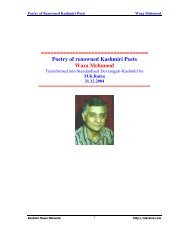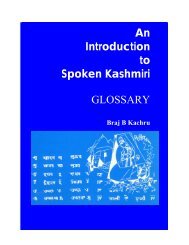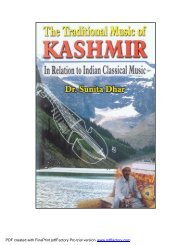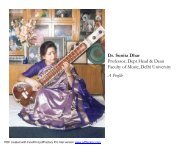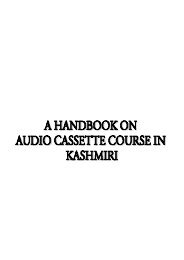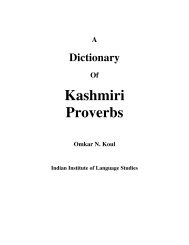Introductory Pages - An Introduction to Spoken Kashmiri
Introductory Pages - An Introduction to Spoken Kashmiri
Introductory Pages - An Introduction to Spoken Kashmiri
Create successful ePaper yourself
Turn your PDF publications into a flip-book with our unique Google optimized e-Paper software.
PREFACE<br />
<strong>An</strong> <strong>Introduction</strong> <strong>to</strong> <strong>Spoken</strong> <strong>Kashmiri</strong><br />
by Braj B. Kachru<br />
In writing a pedagogically-oriented manual for learning a language, it is claimed that an author<br />
generally has a specific type of consumer in mind. These consumers are defined, for example,<br />
according <strong>to</strong> their age group or first language identification, or in terms of their goals for<br />
specialization in a particular second language. If one is guided by the latter category in planning<br />
a textbook, such a textbook is termed a “register-oriented” textbook. However, the producer of<br />
pedagogically-oriented materials soon learns that a pedagogue’s partiality for particular types of<br />
language learning materials is a very personal matter. It is like one’s preference for a particular<br />
vintage of wine or a pinch of special spice in a curry. Perhaps that explains why there still is no<br />
agreement on a theory of materials production. This may also be the reason that there is not a<br />
generally acceptable theory of mother-<strong>to</strong>ngue or second language teaching. It is, therefore, not<br />
surprising that even now the following words of Henry Sweet, written in 1899, continue <strong>to</strong> be<br />
true:<br />
In fact, things are al<strong>to</strong>gether unsettled both as regards methods and textbooks. This is a good<br />
sign: it gives a promise of survival of the fittest. <strong>An</strong>ything is better than artificial uniformity<br />
enforced from without. (The Practical Study of Languages: A Guide for Teachers and Learners,<br />
[London, Dent, 1899], p.3)<br />
There are innumerable manuals and textbooks for teaching of western languages (e.g., English),<br />
yet, the urge <strong>to</strong> produce more—both for the western and non-western consumer—is unlimited.<br />
One reason for this ever increasing production of textbooks is that every intelligent teacher and<br />
student has his own ideas of what makes an ideal textbook. (If there is a general agreement on a<br />
textbook, that is an accomplishment for the author.) Thus, the field of textbook writing continues<br />
<strong>to</strong> be very individualistic.<br />
The tentative and exaggerated nature of contemporary theories, methods and techniques of<br />
textbook writing has not helped the situation. It seems <strong>to</strong> us that the primary reason for this state<br />
of the art is that we still have not gained meaningful answers <strong>to</strong> the basic theoretical and applied<br />
questions which are relevant <strong>to</strong> the textbook writing. For example, there are such questions as:<br />
What are the processes which are involved in the first (or second) language acquisition? or, What<br />
are the theoretical prerequisites for producing a satisfac<strong>to</strong>ry textbook for various types of<br />
learners?<br />
We started with the above digression in order <strong>to</strong> point out that this manual has been produced for<br />
that consumer who is primarily interested in learning the <strong>Kashmiri</strong> language as a <strong>to</strong>ol of cultural<br />
interaction in typically <strong>Kashmiri</strong> situations. The age group, the individuals specialization, or the<br />
learner’s particular first language, did not play a serious role in the planning. The book is,<br />
however, written for the non-<strong>Kashmiri</strong>s who are not familiar with either the <strong>Kashmiri</strong> language<br />
or the distinct culture of the <strong>Kashmiri</strong>s.<br />
In teaching the western languages, a teacher and a learner has, at least, a wide choice in selection<br />
of the materials, since the tradition of the textbook writing in these languages is very old. The<br />
situation in the teaching materials for the non-western languages, especially those of South Asia,<br />
is very discouraging, in terms of both their quality and their availability. Among the non-western<br />
© 2006 Braj B. Kachru (http://kachru.com) i<br />
http://koshur.org/<strong>Spoken</strong><strong>Kashmiri</strong>



